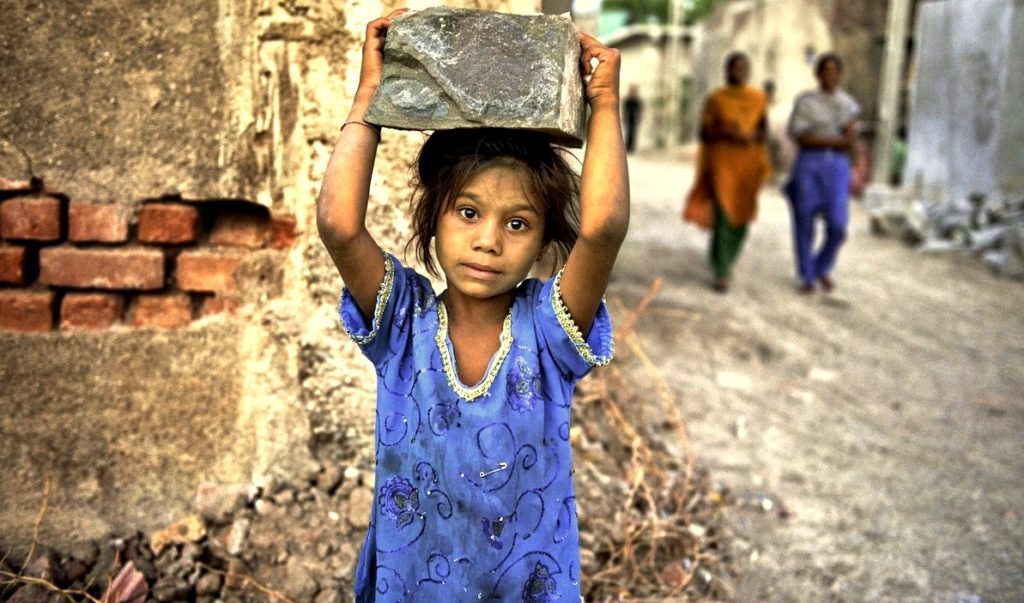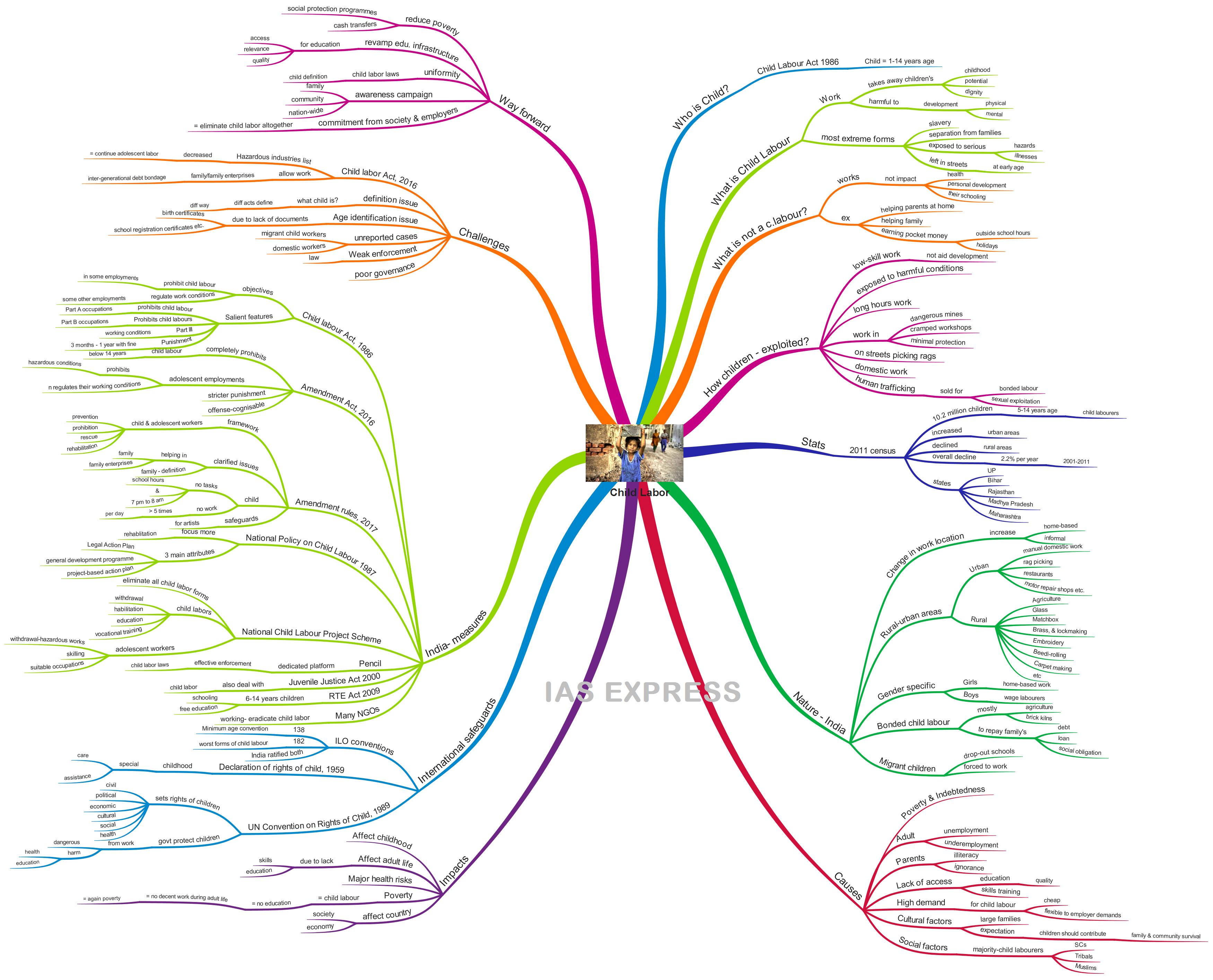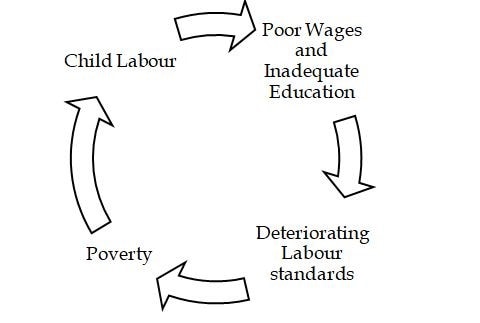Child Labour – India’s Hidden Shame

From Current Affairs Notes for UPSC » Editorials & In-depths » This topic
IAS EXPRESS Vs UPSC Prelims 2024: 85+ questions reflected
One of the most unfortunate consequences of the pandemic and its wide range of restrictions has been the higher vulnerability of children to different forms of abuse and deprivation. Moreover, the second wave of COVID-19 has left several children without both or one of their parents. This situation exposed them to hopelessness, financial hardships and increased risk of child labour, exploitation, and trafficking.
Who is a child?
Child and Adolescent Labour (prohibition and regulation) Act 1986 defines the child as a person who has not completed the age of 14 years.
What is Child Labour?
- Child Labour as defined by the International Labour Organisation (ILO) is a work that takes away children their childhood, their potential and their dignity which is harmful to their physical as well as mental development.
- ILO also explains child labour in its most extreme forms involves children being enslaved, separated from their families, exposed to serious hazards and illnesses and/or left to fend for themselves on the streets of large cities — often at a very early age.
- But Children or adolescents who involve in works that do not impact their health and personal development or affect their schooling is not child labour. For instance, helping their parents at home, helping family or earning pocket money outside school hours and on holidays.
How children are exploited for Labour in India?
Instead of being in school or at play or other constructive activities, they are put to work on a range of activities that span repetitive low-skill work that doesn’t aid development for future employment opportunities, they are forced to be exposed to conditions devastating to health and safety in the agriculture, industry and service sectors.
The work involves long hours on a bewildering range of tasks such as transferring pollen in cotton plants, picking the crop with their bare hands, indentured on tea or tobacco plantations and brick making factories and construction sites; being sent down dangerous mines for extracting gold and diamonds, or confined to cramped workshops for cutting and polishing gemstones; working at slaughterhouses and tanneries with minimal protection or under life-threatening conditions at fireworks factories.
Children are very commonly employed in the murky underbelly of the fashion industry in yarn and spinning mills, and garment factory sweatshops, put to work from handling silkworms in scalding water to doing painstaking embellishment work. They are on the streets picking rags – carrying an entire recycling industry on their shoulders, or in homes doing domestic work either as employees of others or in the case of girls in their own homes where they are treated as free labour and not considered as deserving of education as their brothers.
The worst of all is the human trafficking situations of modern-day slavery that children are thrown into, facing horrific abuse and lifelong trauma as bonded labourers or sold into sexual exploitation. Alongside the physical implications of this work, can we even begin to imagine the mental health consequences for these children and adolescents forced into labour?
What is the statistics of child labour in India?
According to the 2011 census,
- there were more than 10.2 million children in the age group of 5-14 working as child labourers.
- Child labour has increased rapidly in urban areas and declined in rural areas.
- The overall decrease in child labour is only 2.2% per year from 2001-2011.
- India’s biggest child labour employers are – Uttar Pradesh, Bihar, Rajasthan, Madhya Pradesh, and Maharashtra.
What is the nature of child labour in India?
Change in work location: There has been high involvement of children in home-based works and in the informal sector.
Rural-Urban areas:
- In urban areas, a huge number of children are involved in manual domestic work, rag picking, restaurants, motor repair shops, etc.
- In rural areas, children are involved in works as follows,
- Agriculture including cotton growing,
- Glass,
- Matchbox industries,
- Brass, and lock-making factories,
- Embroidery,
- Rag-picking,
- Beedi-rolling,
- Carpet-making industry,
- Mining and stone quarrying,
- Brick kilns,
- Tea gardens etc.
Gender specific: The division of labour is gender-specific with girls being engaged in more domestic and home-based work, and boys working as wage labourers.
Bonded Child labour: refers to the employment of a person against a loan, debt or social obligation by the family of the child or family as a whole. Bonded child labourers are mostly found in the agriculture sector or helping their families in brick kilns, and stone quarries. There are around 10 million bonded child labourers in India.
Migrant Children: Children who are migrating to other locations with family are often forced to drop-out schools and unavoidably put to work at work-sites.
What are the causes of Child Labour in India?
Poverty and Indebtedness:
- Poverty is the greatest cause of child labour. For impoverished households, income from a child’s work is generally important for his or her own survival or for that of the household.
- Children are also bonded to labour because of the family indebtedness.
- Rural poverty and urban migration often expose children to being trafficked for work.
Adult unemployment and under-employment: high prevalence of adult unemployment and under-employment often force children to work to support the family.
Illiteracy and Ignorance of parents: Illiteracy of the child’s parents further worsens the crisis. Illiteracy and Lack of awareness of the harmful consequences of child labour make them violate the law and put their children under the risk of inhuman exploitation.
Lack of access to basic and meaningful quality education and skills training:
- The current educational infrastructure is highly unsuitable to children of economically deprived families.
- Furthermore, the deteriorating quality of education has resulted in increasing dropout rates and forced children to engage in work.
- Compulsory education (RTE) does not cover the 15-18 age group (adolescents). However, being illiterate or school dropouts, these children are vulnerable and most exploited for the informal, unskilled and casual workforce.
Demand for child labour:
- Rising demand for child labour particularly in urban areas is an important cause for the prevalence and increase in child labour.
- Children are employed as they are cheap and flexible with respect to the demands of the employer and not aware of their rights.
Cultural factors:
- An expectation that children should contribute to the socio-economic survival of the family and community, as well as the existence of large families, contribute to the prevalence of child labour.
- Children mostly take up family’s traditional work from an early age. For instance, a Goldsmith’s son takes to gold-smithery, or a carpenter’s child takes up carpentry from an early age.
Social factors: There is a strong correlation between India’s differentiated social structure and child labour. The majority of child labourers in India belong to the so called lower castes (SCs), the tribal and Muslim religious minority.
What are the impacts of child labour?
- Affect childhood: Child labour takes away a child of his/her childhood. It not only denies his/her right to education but also right to leisure.
- Affect adult life: Child labour prevents children from gaining the skills and education they require to have opportunities for decent work when they become an adult.
- Major health and physical risks: as they work long hours and are needed to do tasks for which they are physically and mentally unprepared. Working in hazardous situations adversely impacts a child’s physical and mental health and affects intellectual, emotional and psychological development.
- Poverty: Child labour is both a cause and consequence of poverty. Household poverty makes children enter the labour market to earn money = they miss out on an opportunity to get an education = further continuing household poverty across generations in a vicious cycle.
- Affect country as a whole: Existence of a large number of child labourers has long term effect on the economy and it is a serious obstacle to the socio-economic welfare of the country.
What are the International Safeguards against Child Labour?
International Labour Organization (ILO) Conventions:
- The two Core Conventions directly related to child labour are that of ILO Convention 138 (Minimum age convention) and 182 (Worst forms of Child Labour Convention).
- India has ratified both the Core Conventions of the International Labour Organization (ILO) Conventions.
Declaration of Rights of Child, 1959:
- Universal declaration of human rights 1948 – mentions (under article 25) that childhood is entitled to special care and assistance.
- The above principles along with other principles of a universal declaration concerning child were incorporated in the Declaration of the Rights of the Child, 1959.
United Nations Convention on the Rights of the Child, 1989
It sets out different rights of children- civil, political, economic, cultural, social and health. Article 32 states that the government should protect children from work that is dangerous or might harm their health or their education.
What are the measures taken by India?
Child Labour (Prohibition & Regulation) Act, 1986
Based on the recommendations of the Gurupadaswammy Committee (1979), the Act was passed in 1986. It has the following objectives:
- to prohibit the engagement of children in some employment.
- and to regulate the conditions of work of children in certain other employment.
Salient features:
- The Act prohibits children from working in any occupation listed in Part A of the Schedule; for example: Catering at railway establishments, construction work on the railway or anywhere near the tracks, plastics factories, automobile garages, etc.
- The act also prohibits children from working in places where certain processes are being undertaken, as listed in Part B of the Schedule; for example beedi making, tanning, soap manufacture, brick kilns, and roof tiles units, etc.
- Part III of the act outlines the conditions in which children may work in occupations/processes not listed in the schedule.
- Any person who employs any child in contravention of the provisions of section 3 of the Act is liable for punishment with imprisonment for a term which shall not be less than 3 months but which may extend to one year or fine.
Child Labour (Prohibition and Regulation) Amendment Act, 2016
- The Amendment Act completely prohibits the employment of children below 14 years.
- The amendment also prohibits the employment of adolescents in the age group of 14 to 18 years in hazardous occupations and processes and regulates their working conditions where they are not prohibited.
- The amendment also provides stricter punishment for employers for violation of the Act and making the offence of employing any child or adolescent in contravention of the Act by an employer as cognizable.
Child Labour (Prohibition and Regulation) Amendment Rules, 2017
- The rules provide a broad and specific framework for prevention, prohibition, rescue, and rehabilitation of child and adolescent workers.
- It also clarifies on issues related to helping in family and family enterprises and definition of family with respect to the child.
- It states that the child shall not perform any tasks during school hours and between 7 p.m. and 8 a.m.
- It also provides for safeguards of artists which have been permitted to work under the Act, in terms of hours of work and working conditions.
- It states that no child shall be allowed to work for more than 5 times a day, and for not more than 3 hours without rest.
National Policy on Child Labour (1987)
- It contains the action plan for tackling the problem of Child Labour.
- It focuses more on the rehabilitation of children working in hazardous occupations and processes, rather than on prevention.
- The policy consists of three main attributes:
- Legal Action plan–Emphasis will be laid on strict and effective enforcement of legal provisions relating to a child under various Labour laws.
- Focusing on general development programmes-Utilisation of various on-going development programmes of other Ministries/Departments for the benefit of Child Labour wherever possible.
- Project-based plan of Action– Launching of projects for the welfare of working child in areas of high concentration of child labour.
National Child Labour Project Scheme
- For rehabilitation of child labour, the Government had initiated the National Child Labour Project (NCLP) Scheme.
- The NCLP Scheme seeks:
- To eliminate all forms of child labour through identification and withdrawal children from child labour and preparing them for mainstream education along with vocational training
- To contribute to the withdrawal of all adolescent workers from Hazardous Occupations / Processes and their skilling and integration in suitable occupations.
- Creation of a Child Labour Monitoring, Tracking and Reporting System.
Pencil: The government has launched a dedicated platform viz. pencil.gov.in to ensure effective enforcement of child labour laws and end child labour.
Juvenile Justice (Care and Protection of Children) Act 2000 and Amendment of the Act in 2006
- It includes the working child in the category of children in need of care and protection, without any limitation of age or type of occupation.
- Section 23 (cruelty to Juvenile) and Section 26 (exploitation of juvenile employee) specifically deal with child labour under children in need of care and protection.
The Right to Free and Compulsory Education Act (2009): The Act made it mandatory for the state to ensure that all children aged six to 14 years are in school and receive free education.
Many NGOs like Bachpan Bachao Andolan, ChildFund, CARE India, Talaash Association, Child Rights and You, Global march against child labour, RIDE India, Child line, Kailash Satyarthi Children Foundation etc. have been working to eradicate child labour in India.
What are the Challenges in reducing child labour in India?
Issues with Child Labour (Prohibition and Regulation) Amendment Act, 2016:
- The list of hazardous industries has been drastically decreased, this may allow the employers in industries like chemical mixing units, cotton farms, battery recycling units, and brick kilns, etc. to employ adolescent labour, which they may even get at a much cheaper price.
- Further, the amendment allows a child to be employed in “family or family enterprises”.This raises a question over a large number of child labour in agrarian rural India where poor families are trapped in intergenerational debt-bondage.
Definitional issue: One of the biggest challenges in eradicating child labour is the confusion around the definition of a child, in terms of age, in various laws dealing with child labour.
Lack of identification: Age identification of children is a difficult task in India due to the lack of identification documents. Child labourers often lack school registration certificates and birth certificates, creating an easy loophole in the law to exploit. Most often the children of migrant workers working as labourers and those employed in domestic work go unreported.
Weak enforcement of law and poor governance: Weak enforcement of the law, lack of adequate deterrence and corruption is a major hurdle in eradicating child labour.
What is the way forward?
- Child labour is a vicious circle of poverty, unemployment, underemployment, and low wages. There should be a concerted effort towards social protection programmes and cash transfers to improve the economic situation of families and to reduce the “need” to send children to work.
- There is an urgent need to revamp educational infrastructure- to ensure access to educational institutions, improvement in quality and relevance of education
- There is a need to bring uniformity in existing Indian laws dealing with child labour. The laws must expand the definition of a child by prohibiting the employment of and ensuring free and compulsory education (RTE, Act, 2009) for children below 18 years
- There is a need to launch a national campaign to invoke public interest and large-scale awareness on the exploitation of children and the menace of child labour.
- The government should take adequate measures to raise awareness among families and communities. Parental literacy can play an important role in ensuring the rights of children are upheld.
- Elimination of child labour demands commitment from the society e.g. family, state, civil society and those who employ children in any enterprises.
If you like this post, please share your feedback in the comments section below so that we will upload more posts like this.




WOW this info was awesome